Photos with this report (click to enlarge) | |||
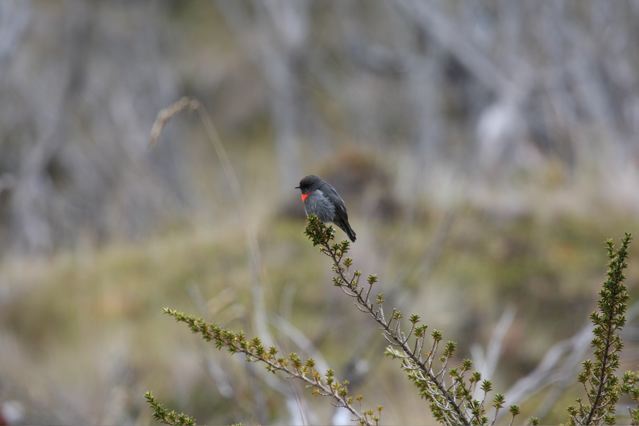 Snow Mountain Robin |
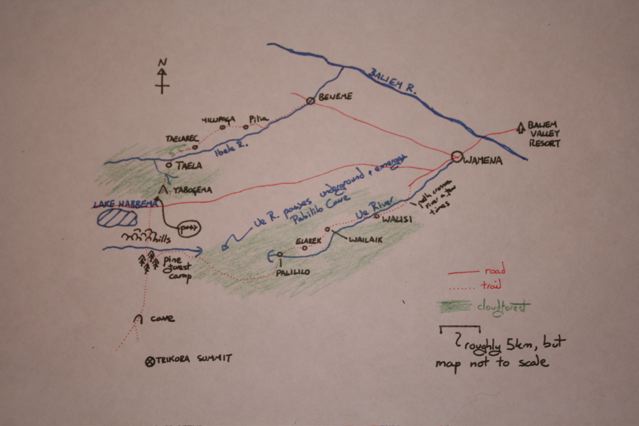 Route map |
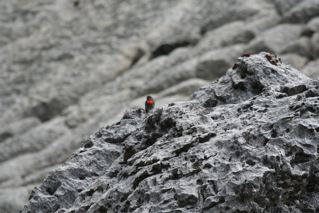 Snow Mountain Robin |
|
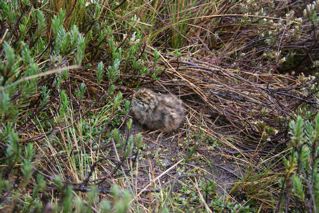 Snow Mountain Quail chick |
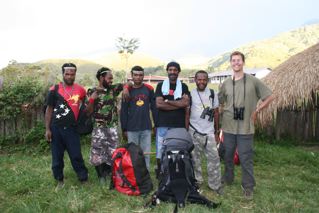 Jonas Wenda and his team |
||
The central mountains of New Guinea are up there among the world’s highest – at just over 4,750m, Mount Trikora (or Mt. Pirgin to the locals) is the second highest peak in New Guinea after Puncak Jaya (5040m), and is bettered only by peaks in the Himalayas and outlying ranges, the western spine of the Americas, East Africa, the Caucasus, as well as Vinson Massif in Antarctica (5,140m), and Mt. Blanc in the Alps (4807m).
Of the two highest peaks in New Guinea, Mount Trikora is by far the easier to visit, since it is only a few days hike from Wamena, the major town in the mountains of West Papua, and only a day or two from Lake Habbema, a tourist destination that is (at least in theory) accessible by road from town.
Puncak Jaya lies some way to the west, and visiting it would require a charter flight and/or a much longer hike. One advantage of visiting this more remote peak, however, would be the chance to see some of the remaining glaciers on New Guinea, fast melting but still extant, unlike the glacier on Trikora, which disappeared sometime in the mid-1900s.
Flights. I flew to Jayapura from Jakarta on Garuda. Despite the concerns about Garuda’s safety standards, this was by far the most confidence-inspiring flight I’ve ever made to West Papua, with an aircraft that was both quite large and reasonably modern. There were two stops, in Ujung Pandang (Makassar) and Biak.
I was able to board a Trigana Airlines flight from Jayapura to Wamena, without having pre-booked, just an hour after arriving in Jayapura. This situation could always change, and if you don’t want to risk it, one of the more expensive hotels in Jayapura or Wamena should be able to book the flight for you.
Flying is the only way to get to Wamena. I was told that a road from Jayapura to Wamena was mostly constructed, but some bridges could not be completed and the whole project has been put on hold. Judging by the excellent forest you fly over to get to Wamena, such a road would be well worth checking out if it is ever built, before the land around it is cleared by new settlers.
The Trigana flight was only an hour on an ageing propeller plane. There are several flights daily between Jayapura and Wamena. In both directions, there were delays of a few hours, and one day the flights were cancelled because of technical problems. I imagine that delays and cancellations would be more frequent in the rainy season.
Money. There are a couple of banks on the main street of Wamena. They will exchange US dollars and probably most other major currencies. But if – like me – you don’t bring enough cash, you may have some problems. Both banks have ATMs, but only one would accept my card, and had a 2.500.000 daily limit. If you are going on a long trip, or are staying at an expensive hotel like the Baliem Valley Resort, it is much safer to calculate exactly what you will be spending, and make sure to bring enough cash along with you.
Safety and permits. Check with your country’s Foreign Ministry (e.g., www.state.gov) for safety information on travelling to West Papua, including Wamena. Members of the Free Papua Movement (OPM) kidnapped a group of Western and Indonesian biologists in a remote area of the West Papuan mountains in 1996.
While you still need a surat jalan to visit Wamena, I was able to fly there before obtaining it. You may need an additional permits to visit Lake Habbema and/or the Mount Trikora summit. These permits may not always be forthcoming! You may be able to find out the current situation before you arrive by contacting a local hotel (like the Baliem Valley Lodge) or guide (like Jonas).
Hotels. I stayed two nights at the Baliem Valley Lodge (http://www.baliem-valley-resort.de), in the hills north-east of Wamena. It is only a few kilometres from town, but the voyage takes about two hours because the road is so terrible. It cost 950.000 Rupiah per night, with extra charges for dinner, laundry etc. There are also some less expensive hotels in Wamena itself.
Transport. A taxi from the airport to the Baliem Valley Lodge will cost about 300.000 Rupiah (subject to bargaining). A taxi from the hotel to the town costs more, about 500.000 Rupiah, although the hotel normally allowed me to hitch a ride on taxis that other guests had ordered. Once, I tried to save money and rent a motorcycle from the town to the resort for about 100.000 Rupiah, but it couldn’t make it all the way and had to walk the last section.
Communications. There is mobile phone signal in Wamena, and most of the time at the Baliem Valley Resort. I lost the mobile signal after hiking a few kilometres into the mountains from Wamena and didn’t recover it at any point before returning to town. Wamena also has an Internet café, and the Internet was working both times I went there.
Logistics for the hike. I made the trip with Jonas Wenda, who handles the logistics for commercial bird tours that visit Lake Habbema, and organizes occasional hiking trips for small groups to the summit of Mount Trikora. Jonas hired four porters for the two-week trip – his nephew Netius, Perus (a friend from his home town), Thomas (a solidly built security guard from the Baliem Valley Resort) and Kipenus, who we met on the way to Taila village. The prices are expensive by Papuan standards – Jonas charged 350.000 Rupiah per day and each porter 80.000 Rupiah per day. I also paid a flat fee of 3.000.000 that covered food and village fees for the two weeks. But it was well worth it – the arrangements were superb. Everyone was great company, the porters all worked very hard and there was plenty of food. You can contact Jonas directly at jonaswenda@hotmail.com or mobile phone 0852-44220825.
Conditions and equipment. If you hire four porters per person (like me), you will only need to carry what you need for the day. The hiking is not too difficult – up to 10km per day at birding pace. The trails can be quite steep. Much of the trail through forest area follows the top of fallen trees – a bit like a boardwalk. Wonderful if you have good balance and are walking barefoot, but very slippery in hiking boots.
It is cold above the treeline. I slept in my clothes in my sleeping bag, but was still too cold and had ice on my tent in the mornings. I also brought a warm winter coat, but it often wasn’t warm enough.
Although it was the dry season, we still had heavy rain several days and nights in the forest. I imagine heavy rain above the treeline could get pretty unpleasant, but we mostly avoided this.
Altitude sickness is a risk here. Even taking several days to hike up, I did have a bit of a headache the first day above the treeline.
Photos. I have reduced the size for the Surfbirds Web site. Please contact me at daviesc1973@hotmail.com if you would like higher quality versions. Please credit “Copyright Charles Davies and Jonas Wenda” – thanks! I also have photos (mostly record shots) of some of the other birds we saw.
Baliem Valley Resort. I stayed here at the beginning and end of the trip. It is a comfortable resort that you could take your family to, with spectacular views down over the Baliem Valley, as well as the place the Trikora summit would be if there wasn’t too much mist. There is a small patch of forest you can walk uphill to behind the resort, but the area is mostly scrub.
Birds: Gray Goshawk, Pied Bushchat, Black Fantail, Golden Whistler, Capped White-eye, Red-collared Myzomela, Marbled Honeyeater, Ornate Melidectes, Red-capped Flowerpecker, Superb Bird-of-paradise (heard only)
Ibele valley villages (4-5 July 2007, 1800-2450m)
Early on the morning of the 4th, we travelled to the town of Beneme, where the road west from Wamene hits the Ibele River (see map). After dropping off two American tourists at the airport, I paid 500.000 Rupiah for the extra distance. Beneme is the start of the route up through the Ibele valley described in “Where to Watch birds in Australasia”. After posing for photos by the road with about half the village’s population, we started hiking up through fields and woodlands of spindly trees, pausing for lunch next to a traditional covered bridge were we met Kipenus, from Taila village, and decided to hire him for the rest of the trip.
After the bridge, the trail climbs steeply for a short way then follows the contours, passing through a series of villages perched on the steep hillside: Pilia (referred to in some reports as Ibele), Millipaga, then Tailarek, where we stopped on the night of the 4th. The villages are surrounded by vertical fields of sweet potatoes, and I wonder how they stop the rain washing away all the soil.
On the evening we arrived at Tailarek, we ran into a local hunter who had just caught a male Splendid Astrapia at a drinking pond staked out by the locals. He had wrapped up the astrapia in banana leaves like the puppy in Epaminondis (see, e.g., www.rickwalton.com/folktale/bryant18.htm) and was planning to sell it in the Wamena market. I decided to buy it (100.000 Rp) and took possession the following morning, intending to release it in the nearest patch of forest, but after a brief display of bravado, it went limp and died. Many of the bird traps we found in the forest consisted of tripwires and arrows rigged up to perches by small pools, either on the ground or in dead trees, where birds come to drink – I’m a bit surprised this approach works in such a wet area.
Climbing further up the valley to Taila, the trail passes through some patches of forest. Everyone we met was very friendly – quite a crowd gathered a couple of times when I was looking at my field guide, and people we passed gave us sweet potatoes, passion fruit, oranges and bananas (Jonas had brought along some chocolate bars and sweets to hand out). The following night, we stayed in the highest group of huts on the slope above Taila, right on the edge of the forest. In the afternoon, a group from the village took us quite some way into the forest to a bowerbird bower (not sure what kind), but we only could spend 20 minutes there and didn’t see it.
Open country birds from Beneme to Taila: Gray Goshawk (1 photographed at Taila at 2450m), Brown Falcon, Glossy Swiftlet, Pacific Swallow, Island Leaf-Warbler, Pied Bushchat, White-shouldered Fairywren, Brown-breasted Gerygone, Red-capped Flowerpecker, Red-collared Myzomela, Ornate Melidectes (7), Superb Bird-of-paradise (3, including 2 males), Black-breasted Munia (several groups totalling about 40 birds, up to the forest edge at 2450m)
Birds in forest patches, mostly between Tailarek and Taila: Plum-faced Lorikeet, Mountain Kingfisher (carrying a pink salamander by the fish ponds in Millipaga), Friendly Fantail, Little Shrike-Thrush Black-breasted Boatbill, Blue-gray Robin, Ashy Robin, Mountain Mouse-warbler (heard), Buff-faced Scrubwren (2), Fan-tailed Berrypecker (1 male), Tit Berrypecker, Rufous-sided Honeyeater, Smoky Honeyeater
Ibele valley cloudforest (Yabogema) (6-7 July 2007)
Jonas and I got up early on the 6th and walked slowly up to Yabogema (I made the altitude there about 2700m), then the following day we walked up above the forest zone. From Taila, the trail ascends steeply into the cloudforest, then descends to the confluence of two rivers (which join to form a tributary of the Ibele). From there, you walk uphill all the way to Yabogema, and above that towards the pass between the Ibele Valley and Lake Habbema. Above about 2900m, the forest becomes very stunted and mossy. It rained heavy the whole night at Yabogema – Jonas and the porters sang rounds around a toasty fire.
Birds in the cloudforest zone below about 2900m: Chestnut Forest-Rail (a pair seen above Yabogema and several heard), White-breasted Fruit-Dove, Papuan Lorikeet, Plum-faced Lorikeet, Yellow-billed Lorikeet, Modest Tiger-Parrot, Fan-tailed Cuckoo, Glossy Swiftlet, Mountain Kingfisher (heard), Hooded Cuckoo-Shrike, Friendly Fantail, Blue-gray Robin, Canary Flycatcher, Orange-crowned Fairywren (one group of 4), hen-plumaged whistler sp., Buff-faced Scrubwren, Papuan Scrubwren, Crested Berrypecker, Red-collared Myzomela, Black-backed Honeyeater, Belford’s Melidectes, Smoky Honeyeater, Torrent-lark (2), Spendid Astrapia (1 male and 5 females), King-of-Saxony Bird-of-paradise (1 male in small bare trees at Yabogema, and 1 female), Brown Sicklebill (1 male calling at dawn in tall trees around Yabogema, and 1 female further downhill)
Birds and mammals in the moss forest zone above about 2900m: Plum-faced Lorikeet, Orange-billed Lorikeet, Friendly Fantail, White-winged Robin (1), Large Scrubwren (2), Papuan Scrubwren, Black-backed Honeyeater, Belford’s Melidectes, Smoky Honeyeater, Splendid Astrapia (2 females), Speckled Dasyure (2)
Trikora/Lake Habbema area (7-13 July 2007).
Above the moss forest, the trail ascends through a narrow zone of heath scrub – it looks a bit like what you find along the coast in southern Australia – then into open country above the treeline, with beautiful views of the forest downhill. Descending the other side of the pass, it is only a few hundred metres before you cross the dirt road between Wamena and Lake Habbema. To continue walking towards Trikora, you cross the road and continue due south. To go to Lake Habbema you have to detour and follow the road about 5 kilometres to the west.
There didn’t seem to be any vehicle traffic on the road and I understand it is closed to tourists at the moment. The main people using it were travellers from the Duga tribe, hiking to and from Wamena. Jonas said it was a very long hike to reach the Duga villages – you have to cross the Trikora massif and continue about 30km the other side along some very difficult jungle trails. But the Duga area is well populated once you reach it – perhaps more heavily populated than the Baliem Valley itself. We bought some packages of pandanus seeds – like long, chewy nuts with a strong flavour of palm – from some of the travellers we met, but rejected the Greater BOP skins that we were offered.
Above the treeline the valleys are broad and flat, covered with boggy grassland dotted with treeferns. The slopes are covered by rather open woodland of Papuacedrus cypresses, with a mossy and grassy understorey. In many areas, all the trees are dead – Jonas said a fire had swept through the area following a serious drought in 1999.
The pines and tree ferns phase out at about 3500m, above which is it grassland and alpine scrub, with only red-and-grey bare rock, lichen and scree above about 3800m, looking much like the top of a mountain in Scotland or Wales. Reaching the summit of Trikora requires mountain climbing – I only got to about 4250m, and even this involved one very steep climb that I wouldn’t have attempted without a lot of encouragement (thanks to Jonas and Thomas)!
Standing on the road to Lake Habbema, you can see the bare rock zone of the highest mountains stretching many tens of kilometres west from Trikora (perhaps all the way to Puncak Jaya?). It all looks like suitable habit for the Snow Mountain Robin – probably no one has been able to survey the areas in-between the two highest peaks.
The land birds are quite similar everywhere at high altitudes around Lake Habbema and Trikora. You get a decent selection of waterbirds on the lake itself. Macgregor’s Bird-of-paradise is associated with the cypress woodland and is fairly common. The normal clue to their presence is the sound of their loud wingbeats, much like those of a hornbill. We even saw a few Macgregors’s BOP well down into the cloudforest zone in the Ue valley (see next section). Although I missed it, Archbold’s Bowerbird has been seen in the Habbema area and adjacent mossy forest. Jonas always sees them together with groups of Macgregor’s Bird-of-paradise. He does another trek to an isolated mountain called Mount Ellit (also 3 days through scrub and villages each way from Wamena), where he sees the bowerbirds more regularly.
Jonas has seen Snow Mountain Robin regularly on mountain-climbing tours along the highest ridgetop of Trikora – higher than I got myself. I found a pair in the bare rock zone at about 4250m, but getting there involved that one very steep climb – maybe Jonas can set up a rope for people to hold on to! We did find one robin below this cliff on the way back down, at about 4050m, but I suppose your chances are better the further you ascend.
Snow Mountain Quail are regular in the flat grasslands – you flush a pair every day or so. The pair we flushed on the way back down from the Trikora Summit area left behind a frightened chick (see photo).
Our itinerary was as follows: 7 July – Arrived at pass between Ibele Valley and Lake Habbema. 8 July – Hike along road to Lake Habbema. 9 July – Back the way we had come, then tacking south across a range of scrubby hills (to 3450m, with Sooty Melidectes at the pass), followed by a spectacular, steep descent to a wide, prehistoric-looking valley with grass and tree fens. After crossing the valley, a couple of kilometres wide, we set up camp in the cypress woodland the southern side. 10 July – Climbed up towards the Trikora summit, camping in a small cave (together with a group of about 30 Duga hikers and a pig that turned up right at dusk). Some nice raspberry bushes around the cave! 11 July – Up to the Trikora summit area, then back to the cave for another night. 12 July – After waiting out some rain, walked back down to the camp in the cypress woodland. 13 July – Hiked east about 7km to the edge of the moss forest in the upper reaches of the Ue Valley, which leads down to Wamena.
We took our time with all the hikes – I mostly walked with Jonas at birding pace. You could get from Lake Habbema to the upper slopes of Trikora in a day if you walked fast.
Birds above the treeline (grassland/woodland) around Trikora and Lake Habbema: Eastern Marsh-Harrier (1), Snow Mountain Quail (7), Dusky Woodcock (heard at the pass between Ibele and Lake Habbema), Plum-faced Lorikeet, Orange-billed Lorikeet (5), Glossy Swiftlet, Alpine Pipit (~80), Island Thrush, Tawny Grassbird, Friendly Fantail (to 3600m), Snow Mountain Robin (3), White-winged Robin (4), Alpine Robin (1), Lorentz’s Whistler (5), Papuan Scrubwren, Papuan Thornbill (~10), Brown-breasted Gerygone, Crested Berrypecker (~35), Red-collared Myzomela, Black-throated Honeyeater (3, all in alpine scrub at 3400-3600m), Orange-cheeked Honeyeater (~200), Black-backed Honeyeater (~10), Short-bearded Melidectes (~20), Sooty Melidectes (1), Belford’s Melidectes, Smoky Honeyeater (to 3500m), Splendid Astrapia (1 female at Lake Habbema), Macgregor’s Bird-of-paradise (~8), Mountain Firetail (4), Snow Mountain Munia (~150)
Waterbirds on Lake Habbema: Little Grebe, Little Pied Cormorant, Salvadori’s Teal (3), Pacific Black Duck, Eurasian Coot
Ue River Valley (13-17 July 2007).
We decided to do a loop and hike back down via the Ue River Valley, which leads east then north to Wamena. This route enters the forest, again through a heath-scrub zone, about 10km east of Trikora, then travels down through the forest for at least another 10km to the village of Palililo, which consists of an area of huts and sweet potato fields surrounded by forest on all sides. The final trek out from Palililo village involves a 2km climb up through forest (with the river in a steep canyon below you), then a descent through villages on the hillside above the Ue River, if anything an even more impressive torrent than the Ibele, and with forest on the opposite bank most of the way back to Wamena.
We stopped for three days in the moss forest zone at 3000m, but endured heavy rain the whole time. Hiked from here down to Palililo in a single day through fabulous forest with tons of birds of paradise, such as 20 astrapias (including 6 males). Worth about a week, I think. Not so Palililo village itself – most of the birds the villagers claimed failed to materialize, and it was difficult to sleep because of the fleas!
I haven’t made a list of the birds in the scrub and fields in the lower Ue valley, but they were similar to those in the Ibele Valley, and included Fan-tailed Cuckoo and Black-breasted Munia.
Birds in the Ue valley moss forest, above 2,900m: Chestnut Forest-Rail (1, with several heard), Dusky Woodcock (one flying over every dawn and dusk), Plum-faced Lorikeet, Greater Sooty-Owl (heard), Orange-billed Lorikeet, Glossy Swiftlet, Mountain Kingfisher (heard), Island Thrush, Friendly Fantail, Dimorphic Fantail (1), Black-breasted Boatbill, Alpine Robin (~10), White-winged Robin, Canary Flycatcher, Rufous-naped Whistler (heard), Lorentz’s Whistler (9), Orange-crowned Fairywren (1 group), Mountain Mouse-Warbler, Papuan Scrubwren, Papuan Thornbill (~10), Brown-breasted Gerygone, Black Sitella (1 group), Tit Berrypecker, Crested Berrypecker, Red-collared Myzomela, Black-backed Honeyeater, Belford’s Melidectes, Smoky Honeyeater, Mountain Peltops (2), Crested Bird-of-Paradise (1 female + 1 juvenile at about 3050m), Macgregor’s Bird-of-Paradise (2 by the camp at 3000m), Splendid Astrapia (4, including 2 males), Lesser Melampitta (1 proving it can fly – or at least flutter – plus a few heard), Mountain Firetail (1)
Birds in the forest below 2,900m (1 day): Great Cuckoo-Dove, White-breasted Fruit-Dove, Papuan Lorikeet, Plum-faced Lorikeet, Yellow-billed Lorikeet, Modest Tiger-Parrot, Friendly Fantail (~30), Dimorphic Fantail (~10), Black-breasted Boatbill (~8), Canary Flycatcher, Black-throated Robin (1), Blue-grey Robin, Ashy Robin (heard), Rufous-naped Whistler (1 plus several heard), Golden Whistler (1 male), Lorentz’s Whistler (3), Mountain Mouse-Warbler, Buff-faced Scrubwren, Papuan Scrubwren (~30), Black Sitella (~10 in 1 group), Red-collared Myzomela, Belford’s Melidectes, Smoky Honeyeater, Great Woodswallow (4 at Palililo), MacGregor’s Bird-of-Paradise (4, down to 2800m), Splendid Astrapia (20, including 6 males), King-of-Saxony Bird-of-Paradise (1 female), Brown Sicklebill (1 male)